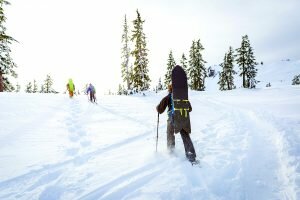 The author drags a hand aboard his powsurfer. Photo by Evan Skoczenski.
The author drags a hand aboard his powsurfer. Photo by Evan Skoczenski.Stepping on the board for the first time felt uncertain and foreign. With little sidecut, let alone edges, and foam deck padding as the only means by which to hold on, this thing was loose. It had only one direction – down – and only one speed – fast. It was equal parts exhilaration and terror. It was perfect.
Looking at it, it’s hard not to feel some sort of camaraderie with those early snowboard pioneers such as Tom Sims and Jake Burton Carpenter. Back in their day, planks of wood, fiberglass and plastic were cobbled together in garages to be ripped down back hills and golf courses alike, all at the hands of DIY-minded kids looking to create something new.
Turns out things don’t change much.
Early this winter, my riding buddies and I decided to make our own fun. Building our own binding-less snowboards, known in some circles as “noboards” or “powsurfers” and descending directly from the first proto-snowboard to carve out of the primordial ooze, the Snurfer, we wanted to know what it was like to free our bind from the traditional snowboard.
Powsurfing has its own particular cult following – a tiny chunk of the snow sports market – and sometimes it even makes the screen in shred flicks. And for good reason as they’re a riot to ride. Normally simple, all wood with some deck grip and, if you’ve an eye for luxury, a P-Tex base, these boards undeniably follow the DIY legacy of what snowboarding is, so it was only a matter of time before we dove into the shop, power tools buzzing.
when you get it right, when you hook into that turn perfectly and float the nose back up and carve right back into another sweep, it’s perfect
Burton had the garage, Sims had a woodshop class and we had an aircraft hangar. While I’m sure the smell of epoxy kicking off was familiar to them, it’s the kind of thing that can make you nervous. A few hours into our first build, we still had a few sheets of wood to lay up, but the last of our gloves lay in sticky clumps at our feet and I’d found out that handling raw fiberglass was a terribly itchy choice. Building your own board, we learned, is a trial by fire.
We started all this off on a damp day in October beneath a tarp, building a mold out of a block of medium-density fiberboard panel, milling it down to get a nose-heavy rocker shape, and then hand sanding in the tail channel and upturned rails. Since we wouldn’t have the type of leverage bindings allow, these rails would give an easier ‘rock’ from edge to edge. Next we assembled our component materials: poplar veneers, triaxial fiberglass, base material and epoxy.
And on a cold November night, beneath the wings of a French Army aircraft, we laid up the first board.
 Nick Belcaster photo.
Nick Belcaster photo.Fifteen hours later we had our first blank to work with, and it was time to get creative. The shape of my own board borrows a lot from fish-style surfboards: a shorter, broader profile with a fat nose and swallow tail, while Chris’ board sports a shovel head and winged tail for plying the depths. With the application of cheap spray paint, neoprene rubber decking and a trip to Boardworks Tech Shop in Bellingham for a basegrind and wax from guru Johnny Lupo, we had our ticket to ride.
We spent the first few months of this season powsurfing, trudging around on snowshoes, taking laps in Swift Creek, falling a lot, laughing. It’s half snowboarding, half sledding with friends in the back yard. It really feels like its namesake, surfing. The smallest weight shift peels the board up and roosts the snow behind you. It’s easy to power around; it’s easy to get bucked off.
 Evan Skoczenski photo.
Evan Skoczenski photo.Soon it’s a game of who can ride farthest, who can acid drop into their line, who can style it out. I think that’s the feeling that spurred all this on – the desire to push things further, get better, go bigger, ride without bindings and see just how far you can push it.
You’ll fall a lot and spend more time wallowing around in the powder, but when you get it right, when you hook into that turn perfectly and float the nose back up and carve right back into another sweep, it’s perfect, it’s bliss – it’s everything. It feels like the first time you ever rode a board, every time.
Nick Belcaster is a Bellingham writer who traverses the Pacific Northwest on rack, rope, skins and boot tread – an ice axe in one hand and a fly rod in the other.